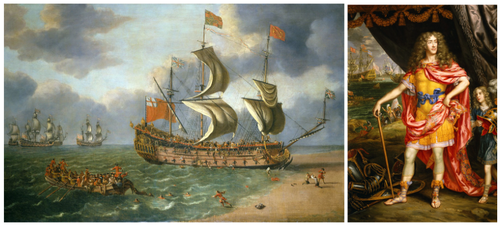Divers Reveal “Historic Maritime Discovery” Of Royal Ship That Sank With King James II
One of the most famous British warships that sank in the 17th century off the coast of England has finally been revealed after two brothers discovered it more than a decade ago.
The 50-gun HMS Gloucester ran aground and sank in 1682 (340 years ago) 27.9 miles off the coast of Great Yarmouth. There was no formal passenger manifest, but it’s believed about 330 people — including James Stuart, future King of England — were on the vessel at the time. It’s estimated that 130 to 250 crew and passengers drowned.
Stuart was nearly one of those casualties –three years later, he was crowned James II as King of England and King of Ireland and James VII as King of Scotland.
The brothers Julian and Lincoln Barnwell discovered Gloucester in 2007. They have been quiet about their findings and, in 2012, were able to confirm the wreck with the Ministry of Defence by identifying the ship’s bell.
It was only until now the brothers have gone public with their findings. Maritime history experts told The Epoch Times this shipwreck is one of the most significant historic maritime discoveries in decades:
“Because of the circumstances of its sinking, this can be claimed as the single most significant historic maritime discovery since the raising of the Mary Rose in 1982.
“The discovery promises to fundamentally change the understanding of 17th-century social, maritime, and political history.
“It is an outstanding example of the underwater cultural heritage of national and international importance. A tragedy of considerable proportions in terms of loss of life, both privileged and ordinary, the full story of the Gloucester’s last voyage and the impact of its aftermath needs re-telling, including its cultural and political importance, and legacy. We will also try to establish who else died and tell their stories, as the identities of a fraction of the victims are currently known,” said maritime history expert Professor Claire Jowitt, of the University of East Anglia (UEA).
The shipwreck’s artifacts will be featured in an exhibition called “The Last Voyage of the Gloucester: Norfolk’s Royal Shipwreck,” jointly curated by UEA and Norfolk Museums Service, at the Norwich Castle Museum & Art Gallery in spring 2023.
“The find would also yield countless more artifacts, including the personal possessions of possibly hundreds of passengers who drowned, wine bottles, and a bell which helped identify the vessel,” Epoch noted.
Here’s a sneak preview of the priceless artifacts recovered by the brothers from the shipwreck over four years.
Footage of Gloucester’s watery grave.
Large cannons
Part of the ship’s anchor
Tyler Durden
Sat, 07/23/2022 – 09:55

